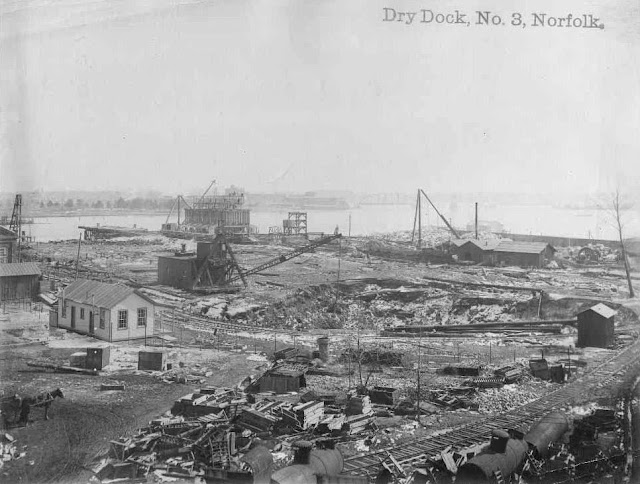Hampton Roads Naval Museum Registrar
Essential to the art of shipbuilding, maintenance and repairs is the dry dock. As a rule, these narrow basins are constructed of earthen berms and concrete. A gate or caisson located at the end of the basin facilitates the flow of water, allowing the vessel to float when the basin is filled or supported on blocks when the basin is drained. While the vessel rests on the blocks, inspections and repairs can be freely made to the normally submerged hull. Afterwards, the vessel can be gently refloated as the water re-enters the basin.
The mark of a true and proper shipyard is its ability to perform dry-docking, and Hampton Roads has the honor of being home to the Norfolk Naval Shipyard. The facility is the oldest and largest shipyard belonging to the U.S. Navy and is located on the southern branch of the Elizabeth River in the City of Portsmouth. There are seven fully functional dry docks at the shipyard, with Dry Dock No. 1 being the most significant. The dry docks are numbered one through eight, but there are actually only seven. Dry Dock No. 5 was originally meant to be a mirror image of Dry Dock No. 4., but it was never constructed. Instead, the land was used for other purposes. These historic gems are not only significant for their inherent historic qualities and showcasing of naval technology, but for their continued service to our country and Navy.
Following is a diagram and early images of the dry docks at Norfolk
Naval Shipyard.
DRY DOCK NO. 1
The most well-known and historically significant of
the shipyard’s dry docks is Dry Dock No. 1.
Construction commenced on December 1, 1827 and was completed on June 17,
1833, the day USS Delaware, the first
ship to be dry-docked in America, entered the dry dock. Nearly 30 years later, the steam frigate USS Merrimac entered the dry dock on May 30, 1861. After the shipyard, then known as the Gosport
Yard, was taken over by Confederate forces during the Civil War, Merrimac was reconstructed there as the
ironclad CSS Virginia. Dry Dock No. 1 is listed on the National
Register of Historic Places.
 |
|
Three unknown vessels (possibly
torpedo boats) in Dry Dock No. 1, February 18, 1908. (National Archives
and Records Administration NNSY-1908_01 /RG 71-CA, Box 333, Folder B)
|
DRY DOCK NO. 2
Dry Dock No. 2 opened on September 19, 1889 and was originally built of
timber. In 1933, it was modernized and
rebuilt of concrete.
DRY DOCK NO. 3
Dry Dock No. 3 opened December 8,
1908 with the docking of the armored cruiser North
Carolina (CA-12). During 1910-11 the
dock was extended from its 550-foot length to its present length of 726 feet.
 |
|
Dry Dock No. 3 under construction, February 3, 1904 (National
Archives and Records Administration, NNSY-1904_01/RG 71-CA, Box 333, Folder D)
|
 |
USS North Carolina (CA-12) in Dry Dock No.
3, December 9, 1908. (National Archives and Records Administration, NNSY-1908_02/RG 71-CA, Box 333, Folder D)
|
DRY DOCK NO. 4
The
U.S. fleet’s newest battleships were longer than the current dry docks in the early
1900s. The Navy’s desire to retain its
ability to maintain its ships created a need for a larger dry dock. The answer was Dry Dock No. 4, the largest
structure to date at that time. It opened
on April 1, 1919. Its length was 1,011
feet, 10 inches. It was 144 feet wide, and was 51feet deep.
 |
|
USS Nevada (BB-36) in Dry Dock
No. 3 and USS Wisconsin (BB-9) in Dry
Dock No. 4 on May 9, 1919. (National Archives and Records Administration, NNSY-1919_09/RG 71-CA, Box 339, Folder D)
|
 |
|
Dry Docks 3 and 4, looking east, March 29, 1935. (National Archives and Records Administration, NNSY-1935_0 /RG 71-CA, Box 334, Folder A)
|
DRY DOCKS NOS. 6 & 7
Both dry docks were built, it seems,
as a pair. They are 465 feet, 9 inches
and 465 feet, 8 inches in length, respectively. Both opened on October 31, 1919.
DRY
DOCK NO. 8
Dry Dock No. 8 has the distinction of being the
largest at the shipyard, measuring 1,092 feet, 5 inches long, with a depth of
47 feet, 11 inches. The battleship Kentucky’s keel was laid on March 7, 1942.
The official opening of the dry dock, however, took place in July, 1942.

 |
|
Both images show Dry Dock No. 8 under construction, looking south, August
14, 1941 (top) and December 15, 1941 (above). (National Archives and Records Administration, NNSY-1941_03
& NNSY-194_-04/RG 71-CA, Box 334, Folder B&A)
|
This brief history of the Norfolk Naval Shipyard’s dry docks is the fourth
in a series of blog posts illustrating the development of Naval Station Norfolk
and its neighboring facilities. Unless
otherwise noted, the photographs in this series represent the results of a
research project seeking images of Hampton Roads naval installations at the
National Archives and Records Administration. This research, performed by Southeastern
Archaeological Research, Incorporated (SEARCH) was funded by Commander, Navy
Region Mid-Atlantic as part of an ongoing effort to provide information on
historic architectural resources at Navy bases in Hampton Roads. The Hampton Roads Naval Museum is pleased to
present these images for the benefit of the general public and interested
historians. As far as we know, all of
these images are in the public domain and none of them have been published
before.






2 comments:
Katherine Renfrew by her research along with the use of these rare photographs obtained in Washington (some that I had not ever seen) has given the reader an excellent overview of the seven Dry Docks at the Norfolk Naval Shipyard. Another well presented article by my friends at the Hampton Roads Naval Museum (HRNM) to honor America's Shipyard.
Katherine, great article, keep up the good work !!
Post a Comment